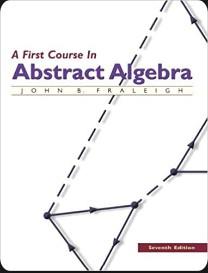In using the three isomorphism theorems, it is often necessary to know the actual correspondence given by
Question:
In using the three isomorphism theorems, it is often necessary to know the actual correspondence given by the isomorphism and not just the fact that the groups are isomorphic.
Repeat Exercise 3 for the group Z36 with H = (6) and N = (9).
Data from Exercise 3
In the group Z24 , let H = (4) and N = (6).
a. List the elements in H N ( which we might write H + N for these additive groups) and in H ∩ N.
b. List the cosets in H N/N, showing the elements in each coset.
c. List the cosets in H/(H ∩ N), showing the elements in each coset.
d. Give the correspondence between H N/N and H/(H ∩ N) described in the proof of Theorem 34.5.
Data from Theorem 34.5.
Let H be a subgroup of G and let N be a normal subgroup of G. Then (HN)/N ≈ H/(H ∩ N).
Proof Let γ : G → G/N be the canonical homomorphism and let H ≤ G. Then γ[H] is a subgroup of G/N by Theorem 13.12. Now the action of γ on just the elements of H (called γ restricted to H) provides us with a homomorphism mapping H onto γ[H], and the kernel of this restriction is clearly the set of elements of N that are also in H, that is, the intersection H ∩ N. Theorem 34.2 then shows that there is an isomorphism µ1 : H/(H ∩ N) → γ[H].
On the other hand, γ restricted to HN also provides a homomorphism mapping HN onto γ[H], because γ(n) is the identity N of G/N for all n ∈ N. The kernel of γ restricted to HN is N. Theorem 34.2 then provides us with an isomorphism μ2: (HN)/N → γ[H].
Step by Step Answer:






